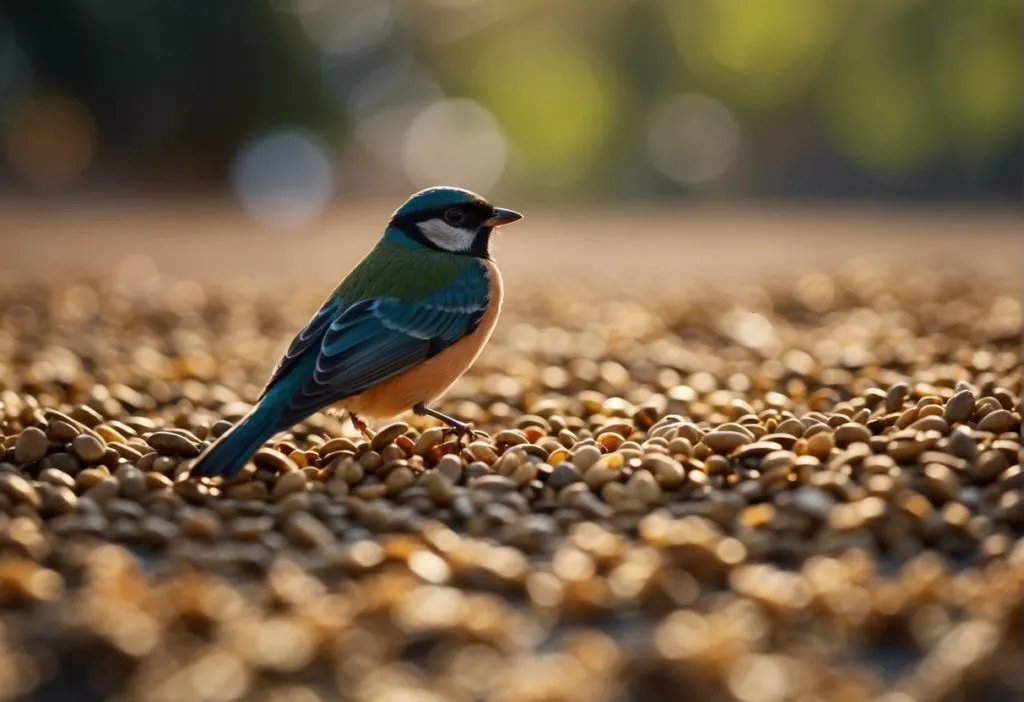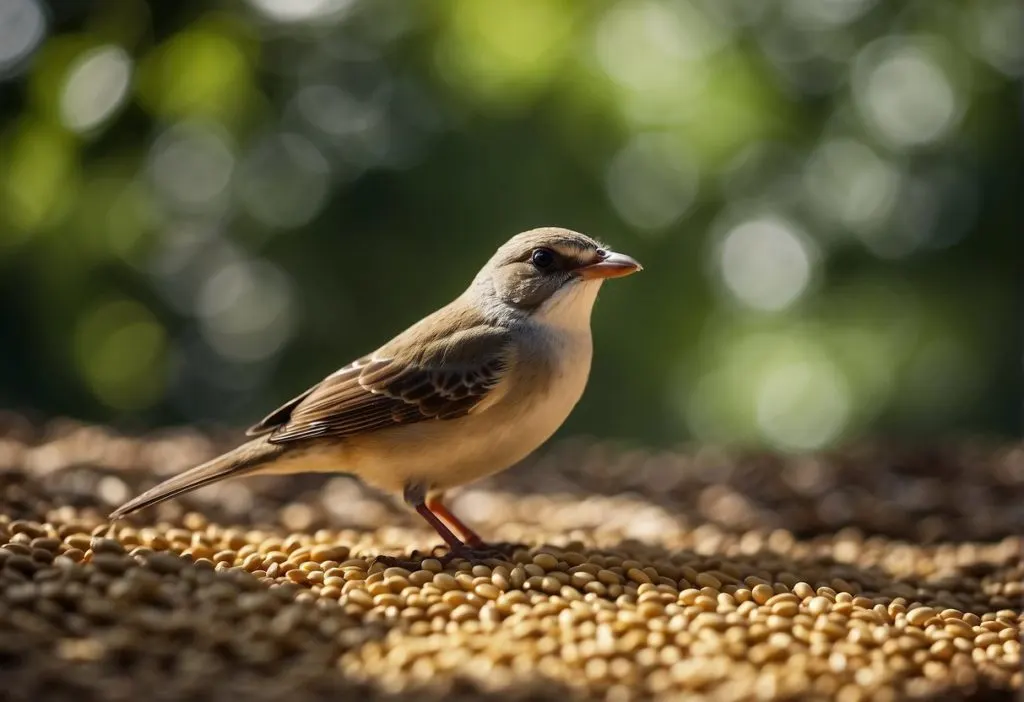Putting bird seed on the ground–a practice called ground feeding–is often considered as a simple and effective way to attract a variety of species to your backyard. However, this method of feeding requires careful attention to avoid potential issues such as spoiled seeds or attracting pests like mice and rats.

Ground feeding can benefit birds that are less likely to visit elevated feeders and can mimic their natural feeding patterns. Yet, it’s important to select appropriate seed types and establish a safe and clean environment for the birds. Let’s look at how to maintain your feeding area to ensure it remains a healthy spot for birds to visit–and just which birds you might attract!
Key Takeaways
- Bird seed can be safely placed on the ground for certain species.
- Proper seed selection and feeder setup are crucial for ground feeding.
- Regular cleaning and maintenance of feeding areas are imperative.
Benefits of Ground Feeding for Birds
Ground feeding can cater to the dietary habits of various bird species that naturally forage on the ground. It typically involves scattering bird seeds or other food items directly onto the ground, providing easy access for ground-feeding birds. They enable species like sparrows, juncos, and towhees, who generally feed at this level, to consume food in an environment that closely resembles their natural foraging conditions.
Accessibility for Different Species: Ground feeding allows:
- Birds unable to perch on feeders to have easy access to food.
- Older or less agile birds to feed without the challenge of a crowded feeder.
Natural Foraging Simulation:
- It replicates birds’ natural feeding patterns.
- Birds can scratch and peck at the ground as they would in the wild.
Attracting a Variety of Birds: A ground feeding approach diversifies the bird population in one’s backyard by attracting a broader spectrum of species. This leads to enhanced bird-watching opportunities, as a wider array of feeding behaviors and species can be observed.
Hygiene and Safety Considerations: While ground feeding has its advantages, one must ensure the cleanliness of the feeding area to prevent attracting pests and to maintain the well-being of the birds. It is recommended to provide food in moderation and in a dry, sheltered area to avoid spoilage and maintain hygiene.
Which Birds Prefer to Eat On the Ground?

Many bird species exhibit specific feeding behaviors, with some expressly adapted to forage seeds from the ground. Depending on where you live, if you feed on the ground, you might attract these birds:
- Sparrows: Various sparrow species, like House Sparrows and Song Sparrows, are often seen foraging for seeds on the ground.
- Doves: Mourning Doves and other doves frequently feed on seeds scattered on the ground.
- Dark-eyed Juncos: These small birds are often found hopping on the ground, picking up seeds.
- Northern Cardinals: While they also feed from bird feeders, cardinals will readily eat seeds from the ground.
- Towhees: These birds, like the Eastern Towhee, often scratch at the ground to uncover seeds.
- Blackbirds and Grackles: These larger birds often feed on the ground, especially in groups.
- American Robins: While known for eating worms, they will also eat seeds from the ground.
- Quail and Pheasants: In areas where they are present, these birds are ground feeders.
- Finches: Some finches, like House Finches, will eat from the ground if seeds are available.
- Chickadees and Titmice: These small birds will occasionally pick seeds from the ground, although they prefer feeders.
These species, among others, commonly consume seeds on the ground as part of their natural feeding routine. Each has adapted to this style of feeding, which is reflected in their typical behavior and physical characteristics conducive to foraging on the ground. Bird watchers can observe these species in natural settings or may attract them to their yards by scattering appropriate seeds on the ground or using platform feeders set close to the ground.
At our house, ground feeding consists of food we feed on the ground–as well as seed that is kicked out of the hanging bird feeders above!
Choosing the Right Bird Seed for Ground Feeding
When selecting bird seed for ground-feeding birds, it is essential to choose types that are preferred by ground dwellers and to employ strategies that minimize waste.
Seed Types Suitable for Ground Feeding
Black Oil Sunflower Seeds: These are a favorite for many bird species, including ground feeders. They have thin shells and are high in fat, making them nutritious and easy to eat. You can also purchase them without shells, reducing cleanup (although increasing your bird feeding costs.)
White Proso Millet: This small, round seed is particularly attractive to sparrows, juncos, doves, and quail that prefer feeding on the ground.
Cracked Corn: Affordable and appealing to a wide variety of birds including doves, sparrows, and blackbirds. It’s also a favorite for ground-feeding wildlife like squirrels and ducks.
Safflower Seeds: These seeds are favored by cardinals and can also attract other birds like doves and sparrows. They have the added benefit of being less attractive to squirrels.
Nyjer (Thistle) Seeds: While often used in hanging feeders for finches, nyjer seeds that fall to the ground can also attract ground-feeding finches and sparrows.
Peanut Pieces: Shelled, unsalted peanuts are a hit with a variety of birds, including jays and woodpeckers, which may drop pieces to the ground for other birds.
Other seeds–from sesame to chia–can also be served on the ground.
Avoiding Seed Waste
Offer the Right Amount: Only offer as much seed as the birds can consume in a day or two to keep the area clean and reduce spoilage. This will also reduce night visits from everyone from raccoons to rats.
Use a Ground Feeder Tray or Platform: Providing a dedicated space for seed can help contain the food and make it more accessible to ground-feeding birds.
Monitor the Seeds: Regularly check the area for any uneaten or spoiled seed to prevent attracting rodents or causing disease among the bird population.
Creating a Safe Ground Feeding Environment
When placing bird seed on the ground, one must prioritize the safety of the birds by addressing the risks of predation and disease transmission. By implementing effective strategies, the feeding area can be made secure and healthy for avian visitors.
Predator Management
To minimize the risk of predation, location is crucial. Feeding areas should be situated away from thick shrubs or hiding places that predators like cats or raptors can use. You can also install a visual barrier, like a garden fence, that allows birds to feed without exposing themselves to potential stealth attacks from ground predators.
- Distances: Keep feeding stations at least 10-12 feet from potential predator hiding spots.
- Visibility: Ensure the feeding site has clear lines of sight in all directions.
Disease Prevention
Disease can spread rapidly among bird populations, especially where gathering is encouraged. To combat this, regular cleaning of the feeding area is essential.
Some people choose to feed on the ground but put the food in a ground feeder, slightly elevated above the ground, to make cleanup easier.
Also, daily raking of the area to remove hulls and uneaten seeds helps reduce mold and bacteria growth.
Maintaining a Clean Feeding Area
Consistency in Cleaning
One should start by regularly cleaning the area under bird feeders to prevent accumulation of discarded seeds, which could attract pests. A consistent cleaning schedule is crucial for maintaining hygiene and making the environment less inviting for unwanted critters.
Appropriate Disposal of Waste
Excess seeds and hulls should be collected using a rake or shovel and properly disposed of. Composting is an environmentally friendly option when it comes to handling organic waste. However, if composting isn’t available, placing the seed waste in the trash is also acceptable.
Surface Selection
The surface underneath the feeders impacts cleanliness and maintenance. Hard surfaces make it easier to sweep up waste, while mulch or gravel can hide seed debris but require more effort to clean. Choose a surface that balances aesthetics with practical cleaning needs.
No-Mess Seed Options
Utilize No-Mess Bird Seed blends, which typically contain hulled seeds to minimize waste. These seeds are without husks, reducing the mess as birds consume them entirely, leaving little to no residue behind.
Regular Seed Removal
Actively remove any wet or spoiled seeds to prevent mold growth and disease. Birds deserve a healthy feeding spot free from potentially harmful contaminants.
| Tips for a Clean Bird Feeding Area |
|---|
| – Regularly clear and clean under feeders. |
| – Dispose of hulls and waste properly. |
| – Choose the right surface under feeders. |
| – Use No-Mess Bird Seed to reduce leftovers. |
| – Remove spoiled seeds promptly. |
Frequently Asked Questions
Can scattering bird seed directly on the ground attract unwanted animals?
Scattering bird seed on the ground can indeed attract various animals aside from birds, such as rodents and pests. These animals are drawn to the easily accessible food source, which can sometimes lead to unwanted infestations and ecological imbalances.
What are the best practices for ground feeding birds without harm?
To feed birds on the ground responsibly, enthusiasts should limit quantities to prevent leftover debris that could attract pests. Also, using a designated area or a ground feeder can help minimize mess and safeguard the health of the birds.
What types of bird feeders are suitable for ground-feeding birds?
Don’t want to sprinkle the food on the ground? For those who prefer feeding ground-foraging species, platform feeders or low tray feeders are often easier for cleanup. These feeders provide easy access and mimic natural feeding conditions, while also helping to keep food off the ground directly.
- 8 Letter Bird Names - August 14, 2024
- 7 Letter Bird Names - August 14, 2024
- 7 Birds Named After Famous People - July 23, 2024
